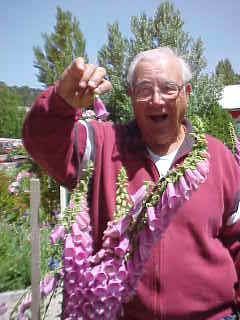 |
||
| Solvang
|
Drip lines save water, cut
down on weeds in garden. by Ed Ando
On Feb. 26 at 7:30 a.m. a sight that reminded me of my childhood passed over my house in Buellton. A flock of Canadian geese flew in a large V, down low, from west to east chattering loudly. I remember lying in bed on an Indiana farm listening to the Southern migration honking through the night. What a lovely sight and sound. Last month's column had a cliff-hanger about saving water and controlling insects. To reduce the water usage in your garden, try drip irrigation. My 10 years experience using drip tape has produced increased yield and water conservation. If you use a fertilizer injector connected to the drip system you will have a careful management of both water and fertilizer. Another bonus is significant reduction in fungus growth and mildew by keeping the foliage dry. Drip irrigation minimizes salinity problems by
reducing evaporation from wet soil surface which concentrates
salt. It irrigates the roots and does not disturb the surrounding
areas. Besides doing away with muddy areas, you eliminate the wind
drift from over-head sprinklers. The small gardener can use the one-quarter inch laser tube drip irrigation. This can be used for trees, roses, hanging baskets and are available in local hardware and garden shops. For the larger gardener, I recommend using drip tape. You can save on your expensive water by using 8-inch emitters. The drip tape comes with emitters built into the tape. The cost is minimal, around $30 for an average garden. Tape at six cents per foot can be used several years. Drip tape uses one-half gallon per minute per 100 feet of tape. Full circle impact sprinklers use 2.68 gallons per minute of 60 pounds pressure covering a 38 foot radius -- more water used, and besides, you get none of the advantages listed above. There are many manufacturers of drip. I suggest you buy all the components from the same manufacturer. My next suggestion will save you many hours of weeding and further reduce your water usage. The black or silver plastic reduces the insect population of white flies, aphids and cucumber beetles. It seems to disorient them because of the light reflection. Use a bulb planter, punch through the plastic and insert your plants. I like to mix soluble fertilizer with water (using directions) and fill the hole made by the bulb planter. Let the water filter down into the soil. This gives the plant a vigorous start. Lay the black plastic over the drip tape. Now you only need to turn your irrigation water on and off. The hardest chore is to harvest your vegetables. You can use six inch by 12 inch yellow sticky insect traps in conjunction with the black plastic, or make your own by painting a board yellow and coating it with tangle trap that is available locally. This can completely eliminate the use of insecticides. For technical assistance on traps, call 800-325-3668. For assistance on drip tape and components, call 805-922-2737. Seeds and catalogs on the
best seller's list. Gardening with Ed first article. [article 2] [article 3] [article 4] [article 5] [article 6] [Article 7] The photo pages take approximately 10 - 30 seconds on a 28 modem to download, well worth the wait. (this page was 19 seconds) |
 Are you
stopping and smelling the flowers? Important in life.
Are you
stopping and smelling the flowers? Important in life.